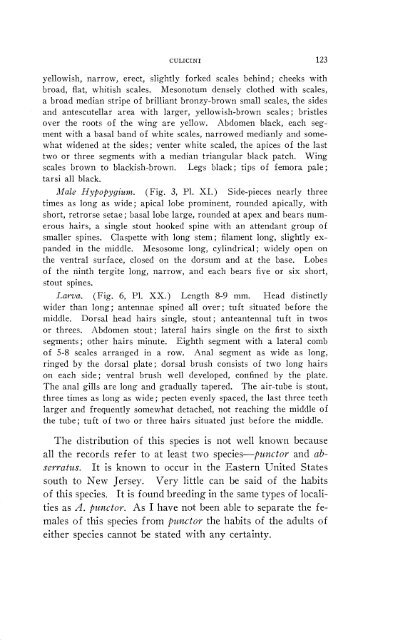a handbook of the mosquitoes of north america - Systematic Catalog ...
a handbook of the mosquitoes of north america - Systematic Catalog ...
a handbook of the mosquitoes of north america - Systematic Catalog ...
Create successful ePaper yourself
Turn your PDF publications into a flip-book with our unique Google optimized e-Paper software.
CULICINI 123<br />
yellowish, narrow, erect, slightly forked scales behind; cheeks with<br />
broad, flat, whitish scales. Mesonotum densely clo<strong>the</strong>d with scales,<br />
a broad median stripe <strong>of</strong> brilliant bronzy-brown small scales, <strong>the</strong> sides<br />
and antescutellar area with larger, yellowish-brown scales ; bristles<br />
over <strong>the</strong> roots <strong>of</strong> <strong>the</strong> wing are yellow. Abdomen black, each seg-<br />
ment with a basal band <strong>of</strong> white scales, narrowed medianly and some-<br />
what widened at <strong>the</strong> sides; venter white scaled, <strong>the</strong> apices <strong>of</strong> <strong>the</strong> last<br />
two or three segments with a median triangular black patch. Wing<br />
scales brown to blackish-brown. Legs black; tips <strong>of</strong> femora pale;<br />
tarsi all black.<br />
Male Hypopygium. (Fig. 3, PI. XI.) Side-pieces nearly three<br />
times as long as wide; apical lobe prominent, rounded apically, with<br />
short, retrorse setae; basal lobe large, rounded at apex and bears num-<br />
erous hairs, a single stout hooked spine with an attendant group <strong>of</strong><br />
smaller spines. Claspette with long stem; filament long, slightly ex-<br />
panded in <strong>the</strong> middle. Mesosome long, cylindrical; widely open on<br />
<strong>the</strong> ventral surface, closed on <strong>the</strong> dorsum and at <strong>the</strong> base. Lobes<br />
<strong>of</strong> <strong>the</strong> ninth tergite long, narrow, and each bears five or six short,<br />
stout spines.<br />
Larva. (Fig. 6, Pl. XX.) Length 8-9 mm. Head distinctly<br />
wider than long; antennae spined all over; tuft situated before <strong>the</strong><br />
middle. Dorsal head hairs single, stout; anteantennal tuft in twos<br />
or threes. Abdomen stout; lateral hairs single on <strong>the</strong> first to sixth<br />
segments ; o<strong>the</strong>r hairs minute. Eighth segment with a lateral comb<br />
<strong>of</strong> 5-8 scales arranged in a row. Anal segment as wide as long,<br />
ringed by <strong>the</strong> dorsal plate; dorsal brush consists <strong>of</strong> two long hairs<br />
on each side; ventral brush well developed, confined by <strong>the</strong> plate.<br />
The anal gills are long and gradually tapered. The air-tube is stout,<br />
three times as long as wide; pecten evenly spaced, <strong>the</strong> last three teeth<br />
larger and frequently somewhat detached, not reaching <strong>the</strong> middle <strong>of</strong><br />
<strong>the</strong> tube; tuft <strong>of</strong> two or three hairs situated just before <strong>the</strong> middle.<br />
The distribution <strong>of</strong> this species is not well known because<br />
all <strong>the</strong> records refer to at least two species+u,nctor’ and ab-<br />
serrates. It is known to occur in <strong>the</strong> Eastern United States<br />
south to New Jersey. Very little can b,e said <strong>of</strong> <strong>the</strong> habits<br />
<strong>of</strong> this species. It is found breeding in <strong>the</strong> same types <strong>of</strong> locali-<br />
ties as A. pz~ctor. As I have not been able to separate <strong>the</strong> fe-<br />
males <strong>of</strong> this species from fwzctor <strong>the</strong> habits, <strong>of</strong> <strong>the</strong> adults <strong>of</strong><br />
ei<strong>the</strong>r species cannot be stated with any certainty.

















